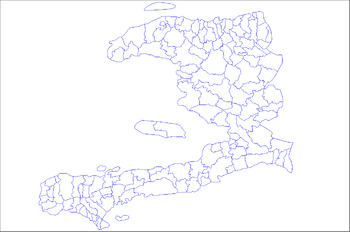Saint-Marc
Saint-Marc (Haitian Creole: Sen Mak) is a commune in western Haiti in Artibonite. Its geographic coordinates are 19°7′N 72°42′W. At the 2003 Census the commune had 160,181 inhabitants. It is one of the biggest cities, second to Gonaïve, between Port-au-Prince and Cap-Haïtien.
Saint-Marc | |
|---|---|
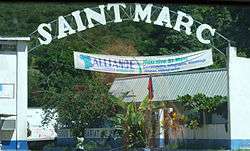 Saint-Marc Welcome Sign at Frecyneau | |
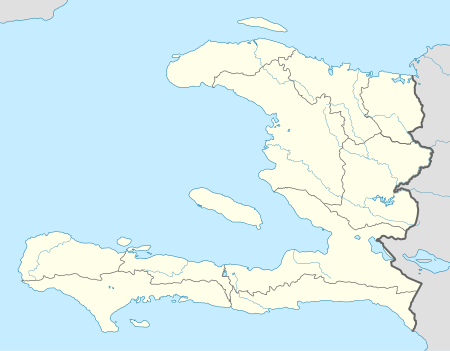 Saint-Marc Location in Haiti | |
| Coordinates: 19°7′0″N 72°42′0″W | |
| Country | |
| Department | Artibonite |
| Arrondissement | Saint-Marc |
| Settled | 1716 |
| Population (2003 Census) | |
| • Total | 160,181 |
| Climate | BSh |
The port of Saint-Marc is currently the preferred port of entry for consumer goods coming into Haiti. Reasons for this may include its location away from volatile and congested Port-au-Prince as well as its central location relative to a large group of Haitian cities including Cap-Haïtien, Carrefour, Delmas, Fort-Liberté, Gonaïves, Hinche, Limbe, Pétion-Ville, Port-de-Paix, and Verrettes. These cities, together with their surrounding areas, contain nearly eight million of Haiti's ten million people (2009).
In 1905 the Compagnie Nationale or National Railroad built a 100 km railroad north to Saint-Marc from the national capital of Port-au-Prince. The track was later extended another 30 km east to Verrettes.
Overview
St. Marc is a large port town surrounded by mountains. At all times, there are many boats in the port, typically sail boats. The town was first settled in 1716, then located in the French colony of Saint-Domingue.[1]
The town is located on flat land close to the sea but its edges extend into the foothills. From these vantage points, the ocean is sometimes viewable. The city has a few park spaces, including Place Cite Nissage Saget. These parks are often surrounded by vendors with carts full of goods.
Local residents enjoy the rich culture of St. Marc and it is considered a safe place to live. About 60% of the population lives in the communal section, meaning outside of town. As a result, they are beyond its infrastructure and lack drainage systems, electricity and potable water.
Recent development projects have been underway in St. Marc, with assistance and funding from USAID and IOM. They include: grading and paving roads, implementing a sewage/drainage system and providing access to potable water at various points throughout the larger town. In addition, a USAID project trained youth to map the town on OpenStreetMap, a free, editable online map.
Transportation
 | |
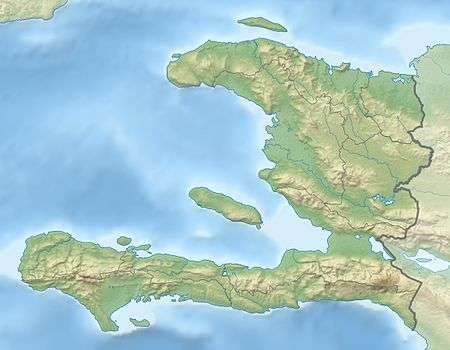 Haiti | |
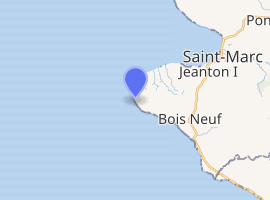
| |
| Location | Pointe de Saint-Marc Artibonite Department Haiti |
|---|---|
| Coordinates | 19°02′44.6″N 72°49′12.7″W |
| Year first constructed | 1924 |
| Foundation | concrete base |
| Construction | metal skeletal tower |
| Tower shape | square pyramidal skeletal tower |
| Markings / pattern | white tower |
| Tower height | 12 metres (39 ft) |
| Focal height | 29 metres (95 ft) |
| Light source | solar power |
| Range | 9 nautical miles (17 km; 10 mi) |
| Characteristic | Q (9) W 15s. |
| Admiralty number | J5404 |
| NGA number | 14224[2][3] |
The way to get from the capital of Port-au-Prince through St. Marc is by means of Route Nationale # 1 (Haiti Highway 1), which extends all the way up to the coastal towns of Montrouis and Gonaïves, before reaching its terminus at the northern port of Cap-Haïtien.
The most prevalent mode of transportation is the motorcycle (mobylette), due to the inexpensive maintenance and low gas consumption. Generally, people fit as many as four on a bike even though the mobylettes are designed for a maximum of two people. Bikes are another common source of transport. Cars are considered a luxury mode of transportation.
St. Marc is known for being a blend of city and rural lifestyles. For many living in Port-au-Prince, it is considered the start of the “country”. Goats are rampant and can be seen roaming about the city streets. Many people in St. Marc also own cows or chickens.
Culture
People
Haitians are a very hospitable and welcoming population, including those in St. Marc. It is said here that “Bonjou is the passport”, meaning that saying hello opens doors. Every time you see someone you know or have just met, you must say either “bonjou or bonswa”, literally meaning ‘good morning’ or ‘good evening’. Typically the person who enters a room makes the greeting.
Although St. Marc is known as the “pleasure city” as many young people reside here; the majority of people live in abject poverty and work extremely hard to make ends meet.
Haitians tend to have a style of talking with powerful projection. Visitors sometimes perceive them to be angry when they are having ordinary exchanges. People in St. Marc enjoy exchanging jokes with each other. Comedy is a favorite pastime.
Music
There are three main types of music listened to in St. Marc:
- Troubadou or twoubadou is very similar to Salsa music and includes drums, trumpets, and guitar.
- Haitian folk music is strongly associated with Vodou. It is often played as processional music in the streets between Ash Wednesday and Easter Sunday.
In St. Marc, many people also listen to popular American music. Popular Haitian groups have developed over the years, such as Les Formidables. This group is no longer together as most members live overseas, but the group’s music lingers in the culture. Virtuose is a very popular group in St. Marc. BC and Gwoup 703 are other popular Haitian groups.
RapCreole is an emerging popular style among the youth. Typically this kind of rap uses rhythms typical of Haitian folk or popular music. Popular ‘RapKreyol’ artists include BC (Barikad Crew), Skwardy, Izolan, Fantom. Sebastien Pierre is a popular R&B artist.
Zomò is one of the most popular singer at Saint-Marc. In 2014, he featured in a music called Lifes goes on which was one of the best in Haiti.[4]
Food
.jpg)
Food plays a large role in the life of people in St. Marc. Meals are an important part of normal daily social interaction. For the most part, cooking is done outside to avoid overheating and moisture collection inside.
Plantains, rice or pasta are staples of almost every meal. Seafood is also consumed regularly. For instance, crab, dried cod and fresh fish are available.
Goat is perhaps the most common meat, but chicken and beef are also consumed regularly. Haitians have an affinity for either very spicy food (even peanut butter is spicy) or very sweet food (sugar is added to sugary cereals). Spices and spicy peppers are used abundantly in Haitian cuisine.
A significant amount of produce is grown locally, specifically bananas, plantains, mangoes, cherries, corn, manioc, rice, and tomatoes. The typical St. Marc resident consumes a lot of fruit. A dish very specific to St. Marc consists of rice with sauce “pois” (beans), crab/goat meat mixed in, or both. Other dishes include bananne pesse (fried plaintains) which are accompanied with piklese, a spicy “gardiniera” mixture that consists of carrots, cabbage, and peppers.
Soup is typically prepared on Sunday to make use of all the week's leftovers. It usually consists of several types of meat, potatoes, and carrots. Fresh fish, typically sole, is also consumed regularly. This fish is cooked over an open fire with a mayonnaise-based marinade mixed with various spices.
Riz du let is a common dessert, essentially a rice pudding made with cinnamon, milk, sugar, and butter. Other Creole-named desserts include dous makos (Haitian fudge), dous kokoye (homemade coconut candy), pen patat (sweet potato bread), pen diri (rice bread), etc.
Religion
Religious believers follow mostly Catholicism and Haitian Vodou. Both are prevalent throughout the country. Catholicism/Christianity is the most widespread and generally accepted religion in St. Marc. Most Haitians attend church on Sundays. Roman Catholicism was brought by the French colonists who settled Saint-Domingue; missionary priests and others worked to convert enslaved Africans. Some 60% of Haitians are practicing Catholics, sometimes combining it with elements of Vodou. Evangelical Protestants and Baptist churches are also very common in St. Marc. The majority of residents are very involved in their church as centers of community and cultural identity. On any given day, groups of people singing hymns can also be heard throughout the streets.
Vodou developed from combining of the different West African religions brought by slaves; the word Vodou is derived from an African word meaning spirit. It is the most widely practiced and considered the official religion of Haiti. Although a few devout Catholics denounce it, the majority of Haitians practice both religions simultaneously. Catholicism is syncretic and has absorbed elements of Vodou. The latter is often referred to for explaining and treating illness. Vodou is more strongly rooted in the rural areas, and this population is more reluctant to accept Western medicine.
Sports
Saint Marc currently has two soccer teams playing in the Haitian professional football league Ligue Haïtienne.
Baltimore Sportif Club and Tempête Football Club
Economy
Commerce is the largest trade in St. Marc. Many find work as a merchant, either with their own stand in the market or at a boutique “convenient store” stand. There are also a multitude of street sellers who carry baskets of goods or candy on their heads, as well as selling canned milk to passers-by. Not many of these products are manufactured in St. Marc.
Nearly all products sold are received in the country as donations or surpluses from second-hand stores in the US. St. Marc markets are open daily, featuring almost any type of fruit or vegetable grown locally. St. Marc hosts a charcoal market for cooking material. As charcoal is used for much of the cooking in St. Marc and throughout Haiti in general, it is manufactured locally and supports a large work force. The island has become deforested from so much wood being taken from the forests.
Aside from the charcoal market, St. Marc’s economics revolve a great deal around agricultural products produced in the area. In Deye Legliz, an area near St. Marc harbor, food markets are open daily. Most residents shop on Saturday to stock up on food supplies for the week.
The Boulevard area houses a large flea market, with a variety of mostly second-hand items sold, including clothing, electronic equipment, shoes, toys, bicycles, etc. Many people from Port-au-Prince come to the markets in St. Marc because of the inexpensive costs.
Shopping
Retail bricks and mortar (or wooden) stores also exist in St. Marc. These include: pharmacies that sell medicinal products, open-air markets (marché) that sell food and many other types of goods, bakeries with wheat and cassava bread and various sweet baked goods, convenience stores, and magazins or specialty shops for such items as fabric, hardware, beauty salons and car parts.
Demographics
According to ARCHIVE Research: In general, people from St. Marc are classified as a Middle class and a Lower Class (the poverty class). The former is generally literate in French, while the latter use Creole and may not be literate. Many of the better schools teach both French and English as formal languages, resulting in children gaining fluency in those and Creole, their first language.
Residents aspire to having a concrete masonry house (CMU), associated with security and wealth. Middle-class families may also wish to save enough money to emigrate with their children from the struggling country. Some observers think the struggle for survival for most families works against joint goals for the city and nation.
Attractions
Going to the beach is a popular activity for families and friends on the weekend. The most popular time to go is on Sunday after church. The most important beaches in St. Marc are Grosse Roche and Amani-y.

Amani-y beach is a white sandy beach. It was abandoned for more than 25 years before being acquired by the current developer. It is the site of a noted "Zombie hole", a 200-meters-deep reef that features large "Elephant Ears" fan coral, sponge tubes, black coral, blue tang, sea urchins, and many more.
Near the beach are some of the region's noted historical sites, such as: the Palace with 365 doors and 52 windows in Petite Rivière de l'Artibonite; the forts in Marchand Dessalines; the pilgrimage site of Saut d’Eau; and the port of Saint-Marc.
An experienced diver has described the diving at Amani-y as follows:
The diving at Amani-y is remarkable and unique. On the east end of the beach, walking out to chest -high water brings you to a dramatic drop-off, a wall going down hundreds of meters. At about 120 feet, a series of giant sponges begins. Making this dive easy is the fact that to the immediate west, a gradual slope takes you up to 30 feet, then 15-20, then ten feet or less, so decompression can be done in a very exciting and relaxing way. The shallower water is perfect snorkeling for non-divers.
Media
FM Radio
- Radio Saint-Marc (4VLF) - Saint-Marc music (local), news
- 104.5 FM Stereo 3.0 kW Radio Max FM - Saint-Marc (Portail des Guêpes)
- 99.1 - RTC-Radio Tele Caleb - Saint-Marc
- 99.9 - Radio Vision 2000 - Saint-Marc
- 101.3 1 kW Radio Super Gemini - Saint-Marc
- 102.9 - Radio Tète a Tète - Saint-Marc
- 104.5 - Radio Max FM - Saint-Marc
- 105.7 500W Radio Delta Stereo - Saint-Marc
- (FM) - Radio Sonic Plus - Saint-Marc
- 105.5 Radio Megalexis
- 97.9 500w Radio L'Union Stéréo-Saint-Marc
Sister cities


References
| Wikimedia Commons has media related to Saint-Marc, Haiti. |
- Buckley, Cornelius Michael (2013). Stephen Larigaudelle Dubuisson, S.J. (1786–1864) and the Reform of the American Jesuits. Lanham, Maryland: University Press of America. p. 2. ISBN 9780761862321. Archived from the original on November 25, 2018. Retrieved November 25, 2018 – via Google Books.
- Haiti The Lighthouse Directory. University of North Carolina at Chapel Hill. Retrieved 22 January 2017
- List of Lights, Pub. 110: Greenland, The East Coasts of North and South America (Excluding Continental U.S.A. Except the East Coast of Florida) and the West Indies (PDF). List of Lights. United States National Geospatial-Intelligence Agency. 2016.
- http://lenouvelliste.com/lenouvelliste/article/140329/AZ-les-voix-de-Life-goes-on
